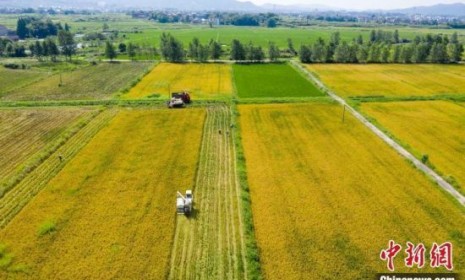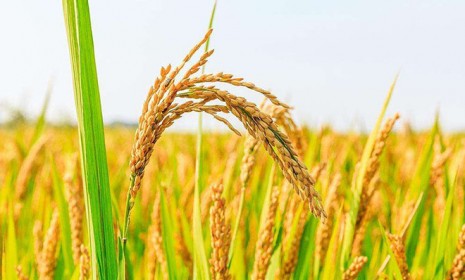近日,水產學院李大鵬教授團隊聯合經濟管理學院與中國科學院水生生物研究所,在Reviews in Aquaculture雜志上發表了題為“Assessing Changes in China's Pond Water Quality From 1989 to 2020: Implications for Green Development in Aquaculture”的研究論文。該研究系統綜述了我國池塘養殖發展歷史,分析了1989-2020年間池塘水質變化規律,綜合評估了池塘水體健康狀況,并結合相關政策和研究進展等闡明了影響池塘水質變化的潛在因素,證明了實施生態優先漁業方針對促進水產養殖業綠色高質量發展的有效性,為全球水產養殖業藍色轉型提供了中國成功經驗。
中國作為水產養殖的發源地,自1989年至今養殖產量均位居世界首位。中華人民共和國成立以來,根據發展方針不同,我國漁業經歷了“以捕為主”、“以養為主,養捕結合”和“生態優先,以養為主,養捕結合”的三個階段。池塘養殖作為主要養殖方式,為我國國民優質動物蛋白和不飽和脂肪酸等營養物質的供給做出了巨大貢獻。然而池塘養殖的快速發展給環境帶來了一定程度的壓力,如高密度集約化養殖造成的水質問題。進入新時代以來,相關部門、科研院校和養殖單位等實施了多項改革舉措、科學研究、技術革新,來促進水產養殖業綠色發展。如農業農村部等十部門于2019年聯合印發《關于加快推進水產養殖業綠色發展的若干意見》著重強調了水產養殖的生態屬性。但目前缺少系統的數據分析來評估水產養殖的生態健康情況。因此,開展大范圍、持續性的養殖水體水質監測,綜合評價養殖活動對養殖水環境的影響,評估當前水產養殖業發展的生態效果,對未來優化漁業管理措施具有重要參考意義。
為此,研究人員通過meta analysis評估了時間、空間、物種等尺度上池塘水環境變化趨勢,并使用ARMA模型預測2035年池塘水體健康狀況。年際尺度分析表明1989年到2012年間池塘水質隨集約化養殖的興起而下降,同時夏秋養殖旺季池塘水質受損程度較高;2013年后池塘水體健康狀況有所好轉。空間尺度分析表明養殖池塘CCME-WQI(水質綜合評價指標,值越大表示水質越好)值呈現出由北向南、由東向西遞增的趨勢。物種尺度分析表明,魚類、甲殼類和軟體動物等多類別混養池塘水質優于魚類養殖池塘。模型預測結果顯示,2035年池塘CCME-WQI值比2020年提高57%。通過分析養殖池塘水質驅動因素發現水質變化與管理政策、養殖方式、社會條件等密切相關,其中池塘養殖方式的轉變是主要原因。
近年來,池塘工程化循環水養殖、多營養層次生態養殖、魚菜共生等生態工程化養殖方式的應用推廣,水產種業、營養飼料、病害防控、水質調控等科技的進步,以及基于生態優先的各種管理舉措共同促使池塘養殖朝著綠色發展。縱觀30多年的養殖池塘水質變化,基于國家生態文明建設總體布局,隨著水產養殖業綠色發展政策實施、綠色養殖新技術和創新模式的發展推廣,池塘養殖可以與自然環境和諧發展、相得益彰。相信在不久的將來,中國漁業生態環境將得到持續改善,水產養殖業也將迎來更加廣闊的發展前景。本研究證實了我國生態文明理念、水產養殖生態優先和綠色發展原則對養殖池塘水體健康狀況管理的有效性,也為全球實現水產養殖業綠色健康發展提供了實踐依據。
華中農業大學水產學院博士生段元帥為論文第一作者,李大鵬和中國科學院水生生物研究所張志敏為論文共同通訊作者。該研究得到了國家重點研發計劃項目、國家大宗淡水魚產業技術體系、國家自然基金等項目資助。
【英文摘要】
Since 1989, China has become the world's largest aquaculture producer through pond culture, significantly contributing to global food security but potentially posing environmental threats. However, little is known about the changes in the pond water quality at broad spatial and temporal scales, thus creating challenges in the sustainability of pond aquaculture. Herein, we explore changes in water quality in China's aquaculture ponds from 1989 to 2020 and assess the waterbody's health status to optimize sustainable management strategies. This study highlights pond water quality changes closely associated with China's aquaculture practices, development, and related policies. Seasonal and regional farming variations significantly impact water quality, with peak aquaculture seasons and Central China and North China associated with the lowest water quality scores. Pond water quality initially declined with the rise of intensive aquaculture but improved after 2012 with the adoption of ecological engineering measures, eco-farming practices, and policies supporting green development. Under a scenario combining these efforts, the water quality score in 2035 is projected to increase by 57% of the 2020 level. These findings reveal that national ecological initiatives and advancements in green aquaculture techniques and public policies can significantly enhance the water quality of China's aquaculture ponds, offering valuable insights into environmental governance in global agriculture.
【文章鏈接】https://onlinelibrary.wiley.com/doi/full/10.1111/raq.12997
日期:2025-02-03
中國作為水產養殖的發源地,自1989年至今養殖產量均位居世界首位。中華人民共和國成立以來,根據發展方針不同,我國漁業經歷了“以捕為主”、“以養為主,養捕結合”和“生態優先,以養為主,養捕結合”的三個階段。池塘養殖作為主要養殖方式,為我國國民優質動物蛋白和不飽和脂肪酸等營養物質的供給做出了巨大貢獻。然而池塘養殖的快速發展給環境帶來了一定程度的壓力,如高密度集約化養殖造成的水質問題。進入新時代以來,相關部門、科研院校和養殖單位等實施了多項改革舉措、科學研究、技術革新,來促進水產養殖業綠色發展。如農業農村部等十部門于2019年聯合印發《關于加快推進水產養殖業綠色發展的若干意見》著重強調了水產養殖的生態屬性。但目前缺少系統的數據分析來評估水產養殖的生態健康情況。因此,開展大范圍、持續性的養殖水體水質監測,綜合評價養殖活動對養殖水環境的影響,評估當前水產養殖業發展的生態效果,對未來優化漁業管理措施具有重要參考意義。
為此,研究人員通過meta analysis評估了時間、空間、物種等尺度上池塘水環境變化趨勢,并使用ARMA模型預測2035年池塘水體健康狀況。年際尺度分析表明1989年到2012年間池塘水質隨集約化養殖的興起而下降,同時夏秋養殖旺季池塘水質受損程度較高;2013年后池塘水體健康狀況有所好轉。空間尺度分析表明養殖池塘CCME-WQI(水質綜合評價指標,值越大表示水質越好)值呈現出由北向南、由東向西遞增的趨勢。物種尺度分析表明,魚類、甲殼類和軟體動物等多類別混養池塘水質優于魚類養殖池塘。模型預測結果顯示,2035年池塘CCME-WQI值比2020年提高57%。通過分析養殖池塘水質驅動因素發現水質變化與管理政策、養殖方式、社會條件等密切相關,其中池塘養殖方式的轉變是主要原因。
近年來,池塘工程化循環水養殖、多營養層次生態養殖、魚菜共生等生態工程化養殖方式的應用推廣,水產種業、營養飼料、病害防控、水質調控等科技的進步,以及基于生態優先的各種管理舉措共同促使池塘養殖朝著綠色發展。縱觀30多年的養殖池塘水質變化,基于國家生態文明建設總體布局,隨著水產養殖業綠色發展政策實施、綠色養殖新技術和創新模式的發展推廣,池塘養殖可以與自然環境和諧發展、相得益彰。相信在不久的將來,中國漁業生態環境將得到持續改善,水產養殖業也將迎來更加廣闊的發展前景。本研究證實了我國生態文明理念、水產養殖生態優先和綠色發展原則對養殖池塘水體健康狀況管理的有效性,也為全球實現水產養殖業綠色健康發展提供了實踐依據。
華中農業大學水產學院博士生段元帥為論文第一作者,李大鵬和中國科學院水生生物研究所張志敏為論文共同通訊作者。該研究得到了國家重點研發計劃項目、國家大宗淡水魚產業技術體系、國家自然基金等項目資助。
【英文摘要】
Since 1989, China has become the world's largest aquaculture producer through pond culture, significantly contributing to global food security but potentially posing environmental threats. However, little is known about the changes in the pond water quality at broad spatial and temporal scales, thus creating challenges in the sustainability of pond aquaculture. Herein, we explore changes in water quality in China's aquaculture ponds from 1989 to 2020 and assess the waterbody's health status to optimize sustainable management strategies. This study highlights pond water quality changes closely associated with China's aquaculture practices, development, and related policies. Seasonal and regional farming variations significantly impact water quality, with peak aquaculture seasons and Central China and North China associated with the lowest water quality scores. Pond water quality initially declined with the rise of intensive aquaculture but improved after 2012 with the adoption of ecological engineering measures, eco-farming practices, and policies supporting green development. Under a scenario combining these efforts, the water quality score in 2035 is projected to increase by 57% of the 2020 level. These findings reveal that national ecological initiatives and advancements in green aquaculture techniques and public policies can significantly enhance the water quality of China's aquaculture ponds, offering valuable insights into environmental governance in global agriculture.
【文章鏈接】https://onlinelibrary.wiley.com/doi/full/10.1111/raq.12997
日期:2025-02-03















